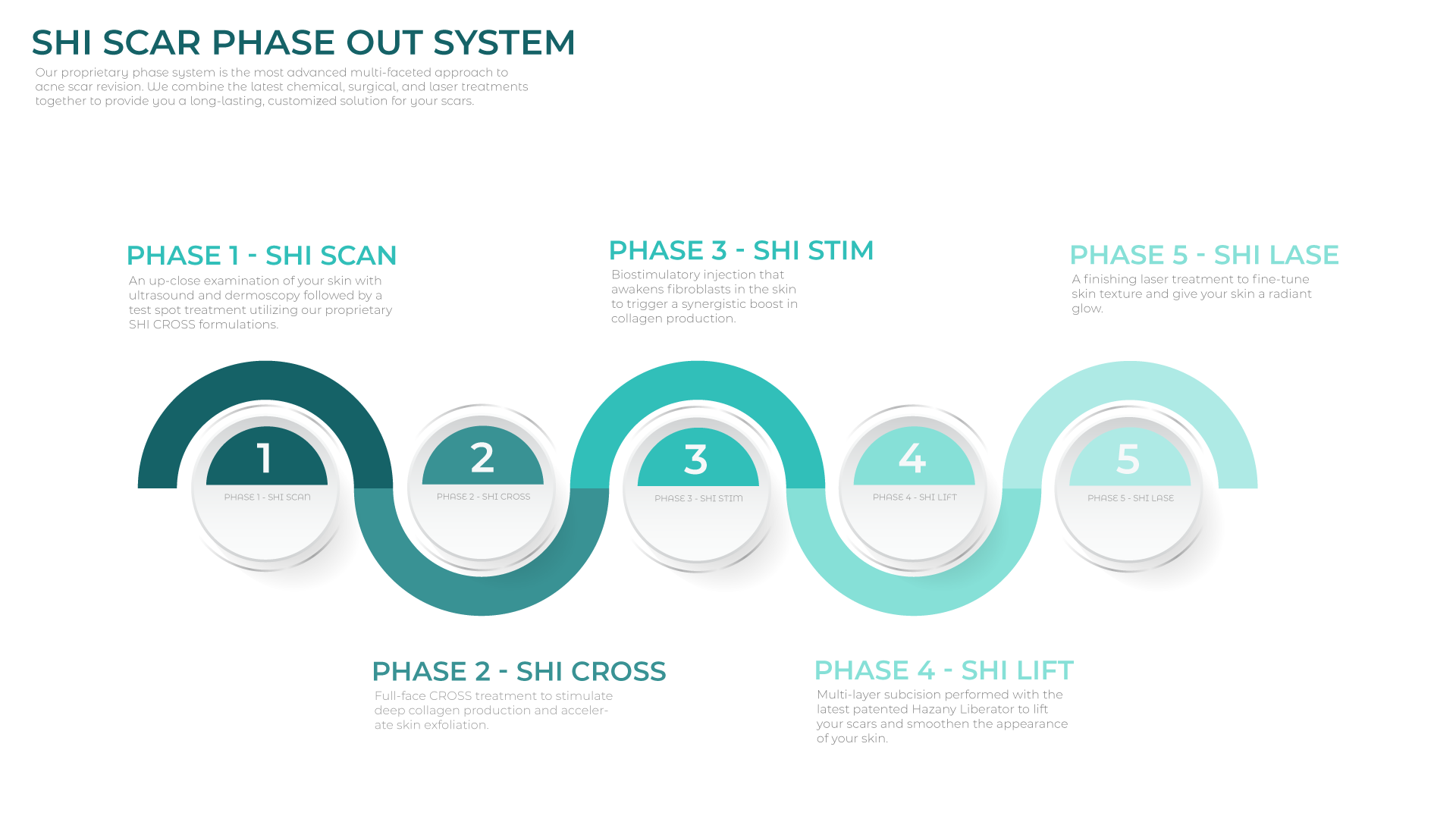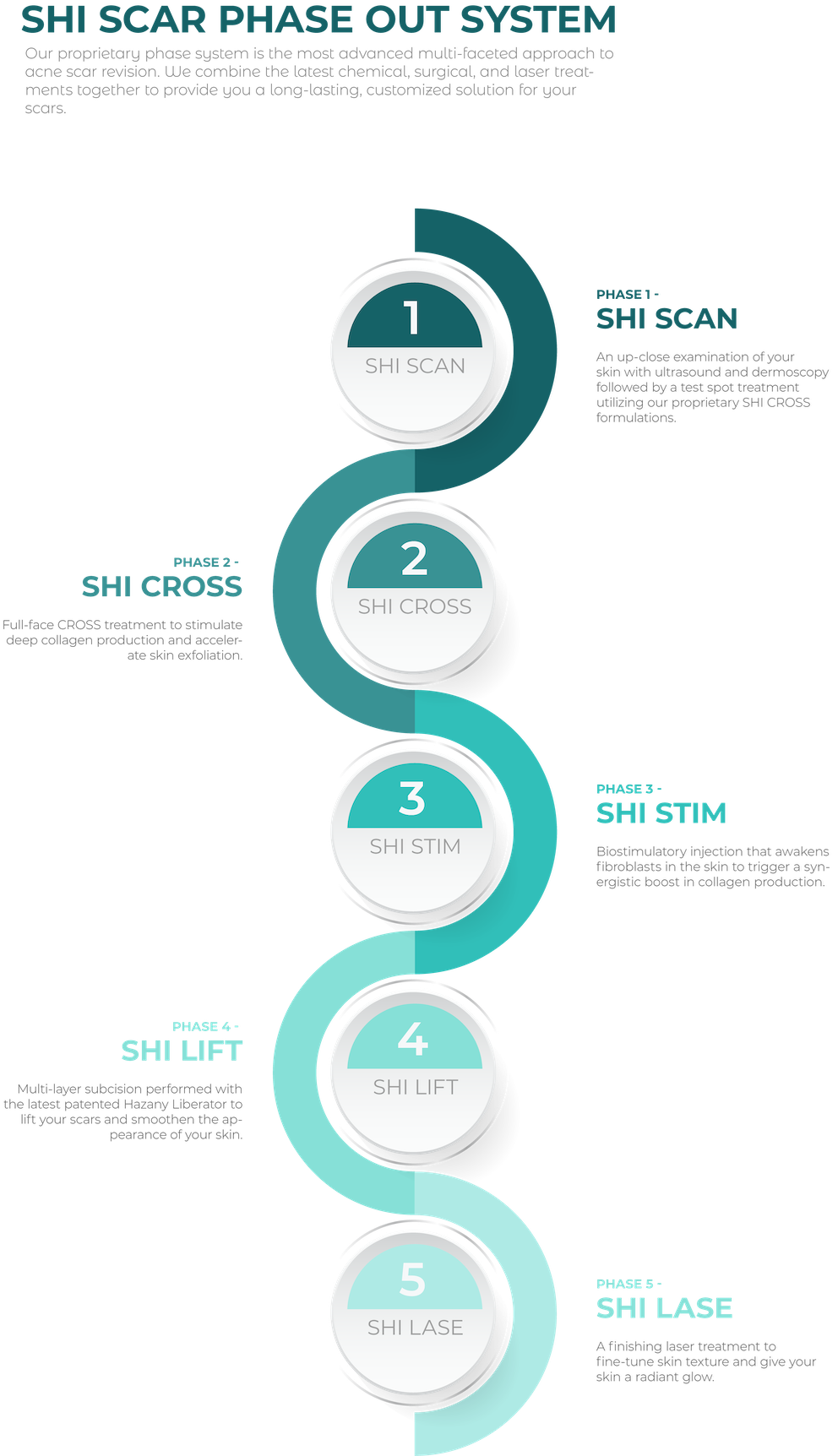If you’re suffering from stubborn acne scars, you might wonder if punch excision is an appropriate treatment for you. Punch excision is a targeted surgical method designed to remove deep, narrow acne scars—mainly icepick and boxcar types—resulting in a more cosmetically favorable outcome. This article will guide you through what punch excision entails, how it’s performed, and what kinds of scars it best treats.
Key Takeaways on Punch Excision
Decoding Punch Excision: A Primer
Punch excision is a surgical procedure specifically designed for the treatment and improvement of certain types of acne scars. It involves the surgical removal of damaged scar tissue, which is then replaced with a thinner, flatter, often linear scar that can be less noticeable. But is this treatment suitable for all acne scars? Not exactly.
Punch excision excels at treating narrow and deep atrophic scars such as deep ice pick scars and boxcar scars, transforming severe and indented scarring into less visible flat linear scars. However, not all acne scars are ideal candidates for this treatment. Raised scars like keloids or hyperpigmentation associated with scarring may not respond as well to punch excision. In such cases, acne scars subcision might be a more suitable alternative for addressing deeper scars, including punch excision scars.
At the Scar Healing Institute (SHI), we often resort to punch excision for treating resistant scarring that may not respond to our Phase System treatment. That said, it’s crucial to have a clear understanding of the punch excision process to appreciate its benefits.
The Step-by-Step of Punch Excision
The punch excision process is a meticulous one, involving a pre-procedure assessment, the actual excision, and post-procedure care.
Let’s take a closer look at each of these stages.
Pre-Procedure Assessment
The punch excision journey begins with a thorough pre-procedure assessment. We identify the scar types suitable for this treatment, which include severe indented scars such as ice pick, boxcar, and some rolling scars. Interestingly, punch excision is suitable for all skin types and can effectively treat various facial regions with deep, narrow scars.
An integral part of this assessment is understanding the patient’s history, including the duration of active acne and past treatments, which aid in determining the appropriateness of punch excision. Moreover, discussing the patient’s concerns and treatment goals is key. This is coupled with a physical examination of the scars’ types and depths to tailor the punch excision approach. To track the healing process, at the Scar Healing Institute, we take professional photos at each stage of treatment in different lighting conditions.
The Punch Excision Process
Once the pre-procedure assessment is complete, we move on to the actual punch excision. The treatment area is first numbed with a local anesthetic, such as lidocaine, to ensure patient comfort. The punch tool, varying from 1 to 12 millimeters to precisely match the scar’s width, is then used to extract the unwanted scar down to the subcutaneous fat layer.
The next step in the punch excision process is closing the wound. Here’s what happens:
- Sutures are strategically placed to aid healing, with special attention paid to evert the wound edges.
- Following this, an occlusive ointment is applied to the wound.
- Finally, a bandage is applied to dress the wound.
The sutures are not permanent fixtures. They are typically removed within one to two weeks following the procedure. This step is crucial for proper healing and reducing the risk of additional scarring.
Post-Procedure Care
Caring for the treated area after punch excision is paramount to ensure optimal results. Mild redness and swelling are normal post-procedure, but it’s vital to monitor for signs of infection, such as increasing pain or discharge, which necessitate immediate medical attention.
Once the skin has healed, it’s advised to apply sunscreen and avoid direct sun exposure to reduce the risk of scarring and discoloration. Complete wound healing generally takes three months, with an early phase characterized by swelling and bruising that may last up to two weeks.
Post-procedure care guidelines include:
- Keeping the dressing dry for the first 24 hours
- Avoiding baths, hot tubs, or swimming for 7 days to prevent complications
- Cleansing the site with warm water and soap
- Keeping it covered to aid the healing process.
Managing any active acne before initiating punch excision is a crucial step to prevent further scarring and ensure optimal results. It’s also important to resolve any red or purple macular discoloration before addressing atrophic scars for a comprehensive treatment approach.
Among the three, ice pick scars are the most difficult acne scar treatment because of their narrowness and depth of penetration. In general, we have found that ice pick scars respond well to phenol CROSS, our frontline treatment method. However, patients with more severe ice pick scars may benefit more from punch excision, a process in which a small “cookie-cutter” tool is used to punch out the ice pick scar.
In this manner, we ensure that the scar is removed in its entirety, as opposed to other treatments that merely treat the surface. The precision and effectiveness of CROSS make it an attractive option for individuals seeking to diminish these types of acne scars and regain smooth, clear skin.
Outcomes of Punch Excision: What to Expect
So, what results can you expect from punch excision? Often, there’s immediate improvement in the appearance of acne scars as the original indented scar is replaced with a flatter, less noticeable linear scar. Healing time generally takes about one to two weeks, although complete healing and scar fading may take several weeks to a few months.
The complete scar remodeling process after punch excision, where new collagen is produced and the scar tissue becomes less noticeable, usually occurs over 3-6 months or longer. However, it’s important for patients to understand that a single punch excision treatment often suffices for ice pick and narrow deep boxcar scars.
But, complete cure of acne scars, including severe acne scars and deep scars, is not always achievable, and multiple procedures, including acne scar surgery and acne scar treatment, are sometimes necessary for treating acne scars and addressing acne scarring.
Potential Complications & How to Mitigate Them
While punch excision has proven to be an effective treatment for certain types of acne scars, it’s not without potential complications. For instance, patients may experience mild tenderness over the treated area once the anesthesia wears off, and the area may be sore or sensitive for a few days as the wounds heal.
Infection is a potential complication that needs immediate medical attention. If signs such as redness, warmth, swelling, increasing pain, discharge, or fever occur, it’s crucial to contact the clinic. To prevent infection, patients can apply a silicone gel such as Epicyn, which contains hypochlorous acid and supports healthy scar tissue growth.
Other potential complications include severe scarring, new scar formation, and post-inflammatory hyperpigmentation. To prevent new scars, it’s essential to keep the wound moist and avoid a thick scab formation. Detailed post-procedure instructions are crucial to minimize risks like bleeding, infection, skin hyperpigmentation, and new scarring, especially after a skin graft.
It’s also important to avoid aspirin and non-steroidal anti-inflammatory drugs after punch excision as they can increase bleeding and risk of complications.
The Longevity of Results from Punch Excision
The results of punch excision are not fleeting. In fact, they are permanent due to the complete removal of the original indented scar tissue. While punch excision typically leaves behind a smaller, softer, and less noticeable scar compared to the original atrophic scars, it’s generally more cosmetically favorable and enhances the treatment’s permanency.
Punch excision for acne is often effective in treating ice pick and narrow deep boxcar acne scars. This demonstrates the procedure’s effectiveness in addressing these specific types of scars. However, the long-term permanency of punch excision results can be influenced if new acne issues arise post-procedure, potentially leading to the formation of new scars.
Combining Punch Excision with Other Treatments
Punch excision is often not a standalone treatment. Combining it with subsequent resurfacing treatments can significantly enhance the overall outcome for acne scar improvement. Significant improvements in acne scar appearance are frequently achieved when punch excision is combined with resurfacing techniques like fractional laser and full ablative laser resurfacing.
Other minimally invasive procedures like microneedling, which can be used with or without Platelet Rich Plasma (PRP), are also commonly employed alongside punch excision to achieve optimal outcomes. The final aesthetic outcome of acne scars treated with a combination of punch excision and resurfacing techniques is typically visible within three months post-procedure.
Tailoring Treatment: When Punch Excision is the Right Choice
Punch excision is tailored to treat specific types of acne scars. It’s optimal for treating those with sharp, defined edges. Suitable scars for punch excision include deep boxcar scars with sharply defined edges and deep, narrow ice pick scars. However, it’s less effective for rolling scars, which have sloping edges and uneven surrounding skin.
The success of managing and removing deep acne scars unreachable by other methods hinges on surgical expertise, highlighting the specialized nature of punch excision procedures. At the SHI, we offer punch excision to treat resistant scarring that may not respond to our Phase System treatment, typically offering it as a later step as part of the fine-tuning process.
Summary
Punch excision is a specialized treatment for certain types of acne scars, transforming the skin’s landscape by replacing indented scars with flatter, less noticeable linear ones. While the treatment is not suitable for all acne scars, it excels in managing deep boxcar and ice pick scars, offering permanent results.
Combining punch excision with other treatments can enhance overall outcomes, and tailoring the treatment according to scar types and patient needs is crucial. Understanding the procedure, its potential complications, and the necessary post-procedure care can help patients make informed decisions and achieve optimal results.
Our Proprietary Acne Scar Treatments
Meet The Acne Scar Phase-Out System
Our proprietary phase system is specifically designed to attack acne scars from all angles: chemical reconstruction from the top-down and physical reconstruction from the bottom-up and from the side. We pride ourselves in our meticulous, personalized, and longitudinal approach to treating your scars.


Skin Acne Treatments & Procedures
While our proprietary phase system is highly customizable and flexible for patients, we recognize that patients may benefit from other procedures as well. Explore these treatment options below and see if they may be right for you!
How Can I Prevent Future Scarring from Happening?
Scarring is more common with poorly resolved cystic or nodular acne. In addition, it has an even greater likelihood of occurring when irritated or squeezed. Therefore, the first step to prevent scarring is to simply leave your acne lesions alone. It is difficult at first, but is worth the patience at the end.
At the same time, it is also important to ensure that your acne lesions do not become over-inflamed. The prolonged inflammation of your active acne will also increase scarring. Steroid injections, notably kenalog injections, are highly effective in quelling inflammation of your acne and thereby limit scarring.
How Do I Know What Type of Acne Scar I Have?
Our specialists at Scar Healing Institute can help identify your acne scar or scarring. We will work with you to create a plan that will help you achieve both mental and physical healing. Find out more!
If you are concerned that you may have acne scars, it is important to consult with a dermatologist or other skin care professional. Our dermatologists will be able to assess your skin and determine if you have any scarring.
Some Frequently Asked Questions About Punch Excision
Yes, punch excision leaves a small superficial scar, usually smaller than the original spot, and it can be effectively treated with cosmetic treatments.
The main difference is that punch grafting involves placing a donor skin graft over the excised area, while excision simply involves removing the affected scar with a punch tool. This differentiation helps in understanding the contrasting techniques and their outcomes.
No, punch excision does not hurt during the procedure. The only discomfort may be the prick of the needle during the injection of the anesthetic solution.
Punch excision wound healing typically takes around three months to complete, with the option for further scar improvement through laser resurfacing around 4 weeks post-procedure.

